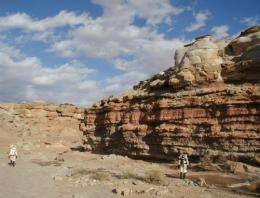November 4, 2009 weblog
Spacesuits with artificial intelligence may look for life on Mars

(PhysOrg.com) -- Astronauts may in future be wearing spacesuits equipped with artificial intelligence (AI) and digital eyes, turning them into what the researchers call cyborg astrobiologists.
University of Chicago geoscientist, Patrick McGuire and his team, are developing a system to recognize the signs of life in barren environments. The system incorporates a form of artificial intelligence called a Hopfield neural network that is programmed to compare incoming data with patterns it has seen before, and identifying those that are different.
McGuire previously worked on a CRISM imager on a Mars orbiter. The imager detects infrared and other wavelengths invisible to humans, which enables it to identify different types of soil and rock. McGuire plans to use this experience in designing digital eyes for the spacesuits. The eyes would provide the data that is then analyzed by Hopfield networks on the hips of the suits.
He envisions the concept as a complex AI system with access to databases of information previously gathered in the area. The system would be able to think about these in similar ways to humans, McGuire explains.
The wearable computer was previously tested at Rivas Vaciamadrid and Riba de Santiuste in Spain, while the cell phone camera was tested in Malta. A complete prototype was tested at the Mars Desert Research Station in Utah. In the tests two scientists wearing spacesuits lived in the field for two weeks as astronauts. They used cell phone cameras and hand-held digital microscopes to gather the data, which was then sent via Bluetooth to the Hopfield network running on netbooks.
In the experiments, they tested the Hopfield neural network algorithm on sequences of images of a variety of rocks and colors from semi-arid regions in Spain and Utah. They found the algorithm could learn colors from one image or just a few, and it could recognize units that had been observed previously from the color data.
The tests successfully differentiated between lichen and surrounding rock and successfully proved the principle is sound. McGuire's next plan is to train the Hopfield network to process data on textures, but ultimately he plans to use the system at scales ranging from the microscopic to entire landscapes.
The system is nowhere near ready for Mars, but the algorithms used to identify and differentiate features could be uploaded to robots sent to explore Mars.

More information: The Cyborg Astrobiologist: Testing a Novelty-Detection Algorithm on Two Mobile Exploration Systems at Rivas Vaciamadrid in Spain and at the Mars Desert Research Station in Utah, P.C. McGuire et at., arXiv:0910.5454.
© 2009 PhysOrg.com















